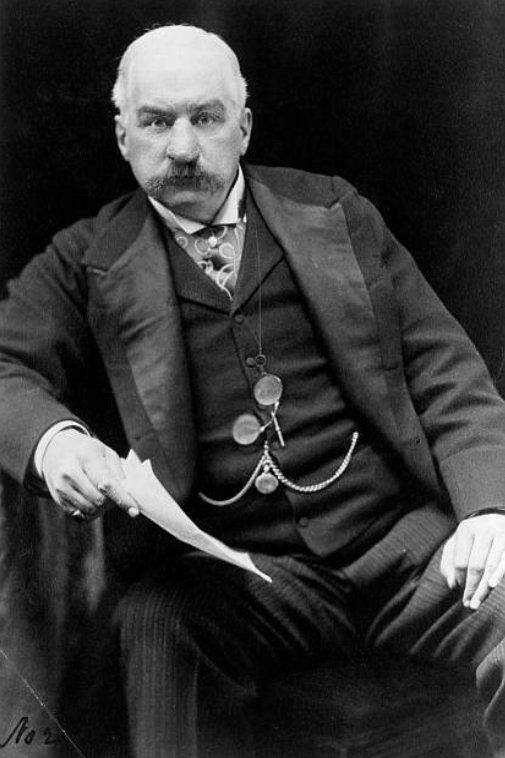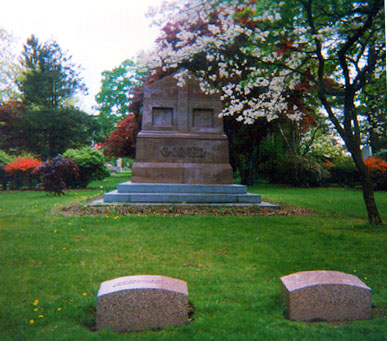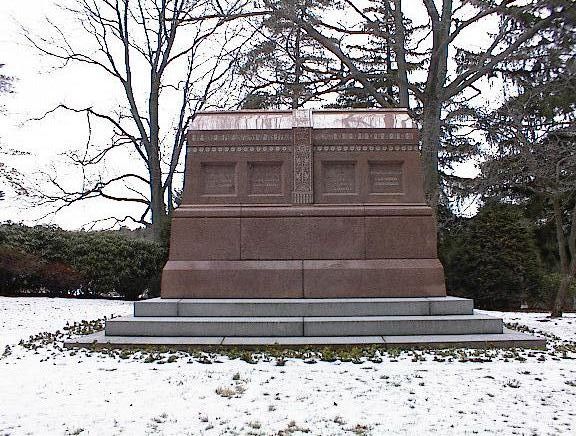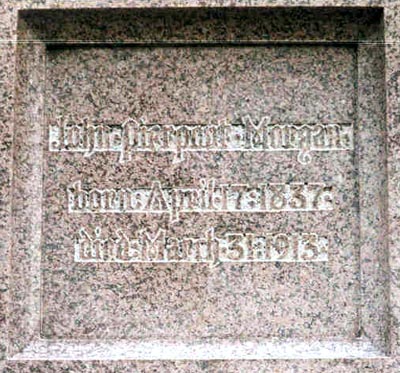Financier, Businessman. He was a United States business tycoon of the late 19th Century and the early 20th Century who became one of the richest men in the world. He was born into a dynasty of banking and the business world. After graduating from a Boston high school in 1854, he studied at the L'Institut Sillig in Switzerland and in Germany at University of Göttingen, excelling in mathematics and becoming fluent in French and German. In 1857, he became an accountant with an American firm that was connected to the George Peabody and Company of London, England; in 1861 he followed in his wealthy father's established banking business; by 1871 had partnered with Philadelphia banker Anthony Drexel; and in 1885 the firm was reorganized as J.P. Morgan & Company, which was a predecessor of the present-day financial giant, JP Morgan Chase. With his Peabody connections in London, he used his influence to help stabilize financial markets during at least two American economic crises, yet he faced public retaliation claiming that he was too powerful and was manipulating the nation's financial system to his advantage. During the beginning of the nation's railroad system, he purchased failing railroad companies owning up to 1/6 of the railroad stocks in the United States. In 1890, his father died leaving an estate of of $10,000,000. In 1895, he assisted in rescuing America's gold standard when he headed a banking syndicate that loaned the federal government $62 million. In 1891, he assisted with the merger of Edison General Electric and Thomson-Houston Electric to form the General Electric Corporation, which became the nation's leading electrical-equipment manufacturing firm. He created the Federal Steel Company in 1898 and merged it with Carnegie Steel Company and other smaller companies to form the United States Steel Corporation, which became the world's first billion-dollar corporation. In 1902, he brought together leading agricultural-equipment manufacturers to form the International Harvest Company. In the same year, he organized the International Mercantile Marine, which managed most of the transatlantic shipping as the company called White Star. In April 1912 he attended the christening of White Star's ship, the "Titanic". He had planned to sail on the maiden voyage but canceled at the last minute due to illness and was horrified to learn that the "Titanic" sank with many deaths. The same year, he testified before a congressional committee, which was investigating a group of Wall Street financiers who allegedly controlled American banking and industries or having a monopoly. At this point, he reorganized his companies causing confusion in the actual ownership or making conglomerates. From this investigation, the Federal Reserve Systems in 1913 and Clayton Antitrust Act of 1914 were created. A stout man with a handle bar mustache, he was an avid art and book collector. Most of his art collection was donated to the Metropolitan Museum of Art in New York City. The building that housed his book collection became a reference library in 1924 and today, it is the Morgan Library and Museum. He married on October 7, 1861 but his bride died of tuberculosis in February 1862; he was a 24 year old widower. In 1865, he remarried and had three daughters and a son. Upon his death, his son J.P. Morgan, Jr. became the heir to an estate of more than $50,000,000.
Financier, Businessman. He was a United States business tycoon of the late 19th Century and the early 20th Century who became one of the richest men in the world. He was born into a dynasty of banking and the business world. After graduating from a Boston high school in 1854, he studied at the L'Institut Sillig in Switzerland and in Germany at University of Göttingen, excelling in mathematics and becoming fluent in French and German. In 1857, he became an accountant with an American firm that was connected to the George Peabody and Company of London, England; in 1861 he followed in his wealthy father's established banking business; by 1871 had partnered with Philadelphia banker Anthony Drexel; and in 1885 the firm was reorganized as J.P. Morgan & Company, which was a predecessor of the present-day financial giant, JP Morgan Chase. With his Peabody connections in London, he used his influence to help stabilize financial markets during at least two American economic crises, yet he faced public retaliation claiming that he was too powerful and was manipulating the nation's financial system to his advantage. During the beginning of the nation's railroad system, he purchased failing railroad companies owning up to 1/6 of the railroad stocks in the United States. In 1890, his father died leaving an estate of of $10,000,000. In 1895, he assisted in rescuing America's gold standard when he headed a banking syndicate that loaned the federal government $62 million. In 1891, he assisted with the merger of Edison General Electric and Thomson-Houston Electric to form the General Electric Corporation, which became the nation's leading electrical-equipment manufacturing firm. He created the Federal Steel Company in 1898 and merged it with Carnegie Steel Company and other smaller companies to form the United States Steel Corporation, which became the world's first billion-dollar corporation. In 1902, he brought together leading agricultural-equipment manufacturers to form the International Harvest Company. In the same year, he organized the International Mercantile Marine, which managed most of the transatlantic shipping as the company called White Star. In April 1912 he attended the christening of White Star's ship, the "Titanic". He had planned to sail on the maiden voyage but canceled at the last minute due to illness and was horrified to learn that the "Titanic" sank with many deaths. The same year, he testified before a congressional committee, which was investigating a group of Wall Street financiers who allegedly controlled American banking and industries or having a monopoly. At this point, he reorganized his companies causing confusion in the actual ownership or making conglomerates. From this investigation, the Federal Reserve Systems in 1913 and Clayton Antitrust Act of 1914 were created. A stout man with a handle bar mustache, he was an avid art and book collector. Most of his art collection was donated to the Metropolitan Museum of Art in New York City. The building that housed his book collection became a reference library in 1924 and today, it is the Morgan Library and Museum. He married on October 7, 1861 but his bride died of tuberculosis in February 1862; he was a 24 year old widower. In 1865, he remarried and had three daughters and a son. Upon his death, his son J.P. Morgan, Jr. became the heir to an estate of more than $50,000,000.
Bio by: Linda Davis
Family Members
Advertisement


















